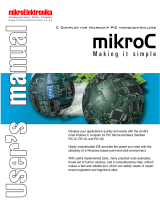
2000 Microchip Technology Inc. Advanced Information DS30475A-page 1
High Performance RISC CPU:
• C-compiler optimized architecture instruction set
• Linear program memory addressing to 32 Kbytes
• Linear data memory addressing to 4 Kbytes
• Up to 10 MIPS operation:
- DC - 40 MHz clock input
- 4 MHz - 10 MHz osc./clock input with PLL active
• 16-bit wide instructions, 8-bit wide data path
• Priority levels for interrupts
• 8 x 8 Single Cycle Hardware Multiplier
Peripheral Features:
• High current sink/source 25 mA/25 mA
• Up to 76 I/O with individual direction control
• Four external interrupt pins
•Timer0 module: 8-bit/16-bit timer/counter with
8-bit programmable prescaler
•Timer1 module: 16-bit timer/counter
•Timer2 module: 8-bit timer/counter with 8-bit
period register (time base for PWM)
•Timer3 module: 16-bit timer/counter
• Secondary oscillator clock option - Timer1/Timer3
• Two Capture/Compare/PWM (CCP) modules
CCP pins can be configured as:
- Capture input: 16-bit, max resolution 6.25 ns
- Compare is 16-bit, max resolution 100 ns (T
CY)
- PWM output: PWM resolution is 1- to 10-bit.
Max. PWM freq. @:8-bit resolution = 156 kHz
10-bit resolution = 39 kHz
• Master Synchronous Serial Port (MSSP) with two
modes of operation:
- 3-wire SPI™ (Supports all 4 SPI modes)
-I
2
C™ Master and Slave mode
• Addressable USART module: Supports Interrupt
on Address bit
Advanced Analog Features:
• 10-bit Analog-to-Digital Converter module (A/D)
with:
- Fast sampling rate
- Conversion available during SLEEP
- DNL = ±1 LSb, INL = ±1 LSb
- Up to 16 channels available
• Analog Comparator Module:
- 2 Comparators
- Programmable input and output multiplexing
• Comparator Voltage Reference Module
• Programmable Low Voltage Detection (LVD)
module
- Supports interrupt on low voltage detection
• Programmable Brown-out Reset (BOR)
CAN BUS Module Features:
• Message bit rates up to 1 Mbps
• Conforms to CAN 2.0B ACTIVE Spec with:
- 29-bit Identifier Fields
- 8 byte message length
• 3 Transmit Message Buffers with prioritization
• 2 Receive Message Buffers
• 6 full 29-bit Acceptance Filters
• Prioritization of Acceptance Filters
• Multiple Receive Buffers for High Priority
Messages to prevent loss due to overflow
• Advanced Error Management Features
Special Microcontroller Features:
• Power-on Reset (POR), Power-up Timer (PWRT),
and Oscillator Start-up Timer (OST)
• Watchdog Timer (WDT) with its own on-chip RC
oscillator
• Programmable code protection
• Power saving SLEEP mode
• Selectable oscillator options, including:
- 4X Phase Lock Loop (of primary oscillator)
- Secondary Oscillator (32 kHz) clock input
• In-Circuit Serial Programming (ICSP™) via two pins
CMOS Technology:
• Low power, high speed EPROM technology
• Fully static design
• Wide operating voltage range (2.5V to 5.5V)
• Industrial and Extended temperature ranges
• Low power consumption
Device
Program Memory
On-Chip
RAM
(bytes)
On-Chip Off-Chip
EPROM
(bytes)
# Single
Word
Instructions
Maximum
Addressing
(bytes)
PIC18C658 32 K 16384 N/A 1536
PIC18C858 32 K 16384 N/A 1536
PIC18CXX8
High-Performance Microcontrollers with CAN Module






















